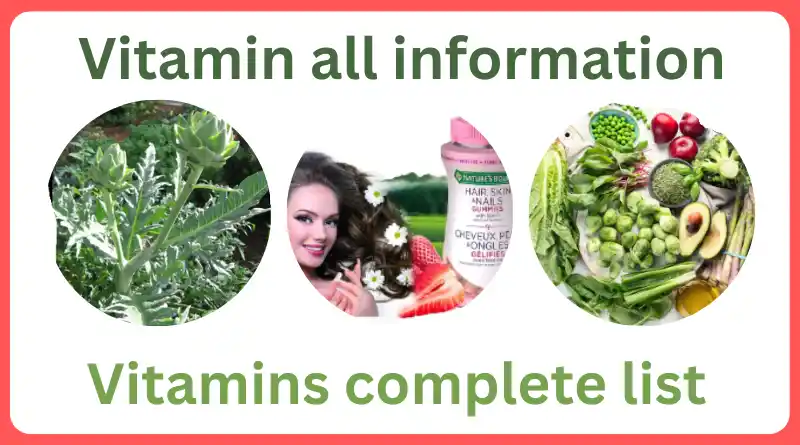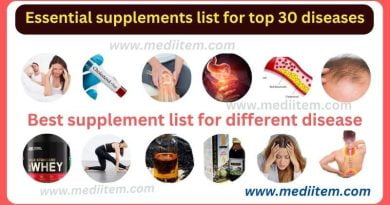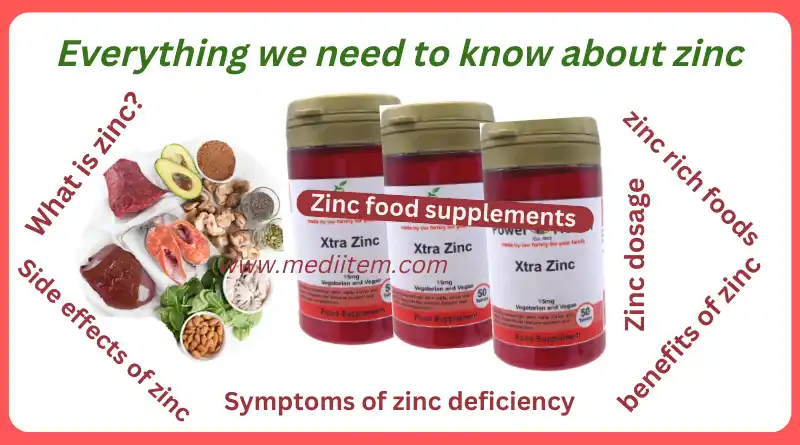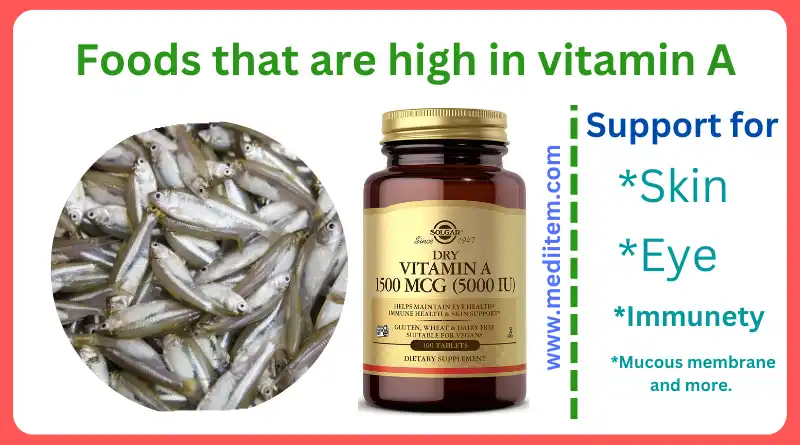Vitamins complete list and more information
Vitamins complete list are substances that are present in very small amounts in food, but that the body needs for normal growth and development. They are vital factors in the diet, all vitamins were discovered about the diseases that caused their deficiency. The body needs 13 vitamins, which are: vitamins A, C, D, E, and K, and the B complex (*B1-thiamin, *B2-riboflavin, *B3-niacin, *B5-pantothenic acid, *B6-pyridoxine, *B8-biotin, *B9- folic acid and *B12-cyanocobalamin)
In general, through a balanced diet that includes all food groups, it is possible to cover the daily needs of vitamins, since food is the greatest source that provides said micronutrients. Another source of vitamins is vitamin supplements, in our market, we have a wide range of them, however, it is advisable to consult with your doctor. Each vitamin has specific functions and is found naturally in different foods, so we will go into detail about each of the vitamins below.
Complete list of vitamin A
Vitamin A or retinol is fat-soluble and its precursor is the provitamin beta-carotene (a substance that gives carrots their orange color). It plays an important role in biological processes such as reproduction, regeneration of skin, hair, or nails; the development of good vision, the immune system, mucous membranes, bones, and teeth; as well as cell protection. In addition, being a fat-soluble vitamin, it is stored in the liver.
Function in the body: Currently there are more and more studies on the various functions that this vitamin performs in the body, highlighting its role in the physiology of vision, differentiation of epithelial cells, growth, reproduction, and antioxidants.
Food source: It is found mainly in the fat of certain foods of animal origin such as meat, fish liver, beef liver, lamb or pork, egg yolk, butter, and cheese. On the other hand, carotenoids (provitamin A) are found in vegetables colored red, yellow, or green. As they are in: carrot, tomato, pumpkin, spinach, and melon, among others.
Where it is found: The provitamin beta-carotene is found in plant-based foods such as carrots, yellow, orange, red, and green fruits (such as apricots, peaches, cantaloupe, and papaya); and in vegetables. Vitamin A is found in foods of animal origin such as cod liver oil, butter, cheese, milk, eggs, meat, liver, and kidneys. The “top” for winter: red peppers, green cabbage, carrots -also in juice-, matcha tea, Brussels sprouts, and other varieties of cabbage. Also broccoli, spinach, cucumbers, endives, soybean sprouts, chicory, or celery. Read more: Foods that are high in vitamin a
Vitamins E complete list
The main function of vitamin E is to act as an antioxidant to counteract the harmful effects that oxygen can have on tissues. Vitamin E, therefore, is a very important substance to preserve the health and well-being of people. is necessary for the functioning of the immune system and contributes to cell protection throughout the body. Likewise, this vitamin has been linked to the prevention of a series of diseases such as cancer, eye disorders, cardiovascular diseases, Parkinson’s, or diabetes mellitus.
Below you will find information on what vitamin E is and especially what foods rich in that are ideal as a source of this nutrient, what precautions we must take into account to take it, and what possible adverse effects it can have if it is not ingested the correct way.
Walnuts: are very nutritious and provide multiple benefits for our bodies. It is a food rich in nutrients such as omega-3 fatty acids, other healthy fats, proteins, and vitamins such as E and B6. Also, eating nuts regularly helps prevent cardiovascular diseases due to the L-arginine they contain. Its high content of vitamin E helps brain health, favoring its proper functioning and good memory.
Plant oils: such as olive, coconut, cottonseed, safflower, hemp, or wheat germ oil are very rich sources. It is recommended to use these oils cold, unrefined, and organic.
Wheat germ oil is the food with the most known: it usually contains 520 mg of vitamin E per 100 g. A single tablespoon of wheat germ oil contains 100% of the daily amount needed for vitamin E.
Chard Swiss: is also rich in vitamin A, vitamin C, and vitamin K. Just one cup of boiled Swiss chard provides almost 17% of the recommended daily value of vitamin E. The abundance of iodine in this vegetable is also very beneficial for our metabolism, as it regulates our energy level and promotes the proper functioning of our cells. In addition, this type of food helps to take care of ourselves from the inside, regulating our cholesterol. It is a food rich in iodine, it also helps to process carbohydrates and strengthen hair, nails, skin, etc.
Avocado: Just half an avocado contains more than 2 mg of vitamin E. Avocado contains unsaturated fats, vitamins, potassium, minerals, and fiber. Likewise, this food also helps reduce cholesterol, aid digestion, soften the skin, and control blood pressure. Apart from vitamin E, avocado also contains other vitamins such as k and b.
Sources Vitamins e complete list
- Almonds: 6.8 mg in a one-ounce serving
- Sunflower seeds: 7.4 mg in a one-ounce serving
- Peanut butter: 2.9 mg in a two-tablespoon serving
- Peanuts: 2.2 mg in a one-ounce serving
- Spinach: 1.9 mg in a half-cup serving
- Broccoli: 1.2 mg in a half-cup serving
Vitamin E deficiency is very rare in healthy people, but if you have one of the pre-existing conditions listed above and are experiencing symptoms like muscle weakness, coordination problems, or numbness and tingling, it’s important to see your doctor.
Complete list of Vitamin C
Role in the body: The functions it performs are numerous and important. It acts: as a cofactor for at least eight enzymes, in the metabolism of certain trace elements, in the immune system, and the nervous system, In hepatic biotransformation (it is necessary for the elimination of drugs and carcinogens) it is an antioxidant. Like vitamin B, it is water-soluble, so it is important to incorporate it into our daily diet to ensure regular consumption. It is useful for the body, with benefits for the immune system, the skin, and connective tissue,
The venous and arterial walls, the gums, visual acuity, and the nervous system. In addition, it positively influences good mood, concentration, sleep, and stress resistance, and has antioxidant properties. Food sources of vitamins complete list: Fruits and vegetables are the greatest sources of vitamin C: citrus, melon, strawberries, kiwi, tomato, cauliflower, cabbage, red and green peppers, and green leafy vegetables.
Among foods of animal origin, it is found in minimal quantities in viscera, except in the liver, which is an excellent food source. It is almost non-existent in meat and derivatives, dairy products, and eggs. in all fruits and vegetables, especially cherries, acerolas, rose hips, sea buckthorn berries, blackcurrants, kiwis, citrus fruits (lemon, orange, tangerine), strawberries, fennel, and spinach.
The “top” for winter: peppers, sauerkraut, Brussels sprouts, broccoli, green and Chinese cabbage, Swiss chard, leeks, endives, matcha tea, beets, radishes, onions, potatoes, citrus fruits, pears, and apples. Read more: Ascorbic acid formula vitamin C supplements
Vitamin D List
Function Vitamin D and D3 information In the body: Increases the absorption of calcium at the intestinal level, mobilizes calcium and phosphate from the bone, as well as acts on the renal reabsorption of calcium and phosphate. is formed in the epidermis thanks to sunlight. Due to the lack of light, in winter the body needs an extra supply of food, since this vitamin strengthens the teeth, bones, nervous and immune systems, and promotes optimism and relaxation.
Foods source of vitamins complete list: There are very few foods that contain natural, these are: fatty fish (salmon, herring, sardines, cod, etc.), eggs, meat, and milk. in fatty fish, eels, or herring; and cod liver oil. Also in egg yolk, whole grains, and mushrooms. The “top” for winter- whole grains, mushrooms, fish oils, etc -in small quantities. Read more: How much vitamin d3 should I take daily
Vitamin K complete list
Function in the body: It is a fat-soluble important vitamin for blood coagulation and is involved in the different factors involved in coagulation.
Foods in vitamin K sources: vegetables (turnips, cabbage, lettuce, peas, among others), oil (soy, rapeseed, and olive), liver, eggs, and cheese. poultry meat, beef liver, dairy products, green leafy vegetables, and aromatic herbs such as sage, and celery contain vitamin K. sauerkraut, Brussels sprouts, spinach, cauliflower, and broccoli.
Vitamin B complete list
Such as B to B6, B9, and B12 vitamins complete list. Vitamins B metabolize lipids, proteins, and carbohydrates; they maintain the proper functioning of the nervous system and produce red blood cells. They also help the immune system and defenses, protect the mucous membranes, and are key to the production of growth hormones, hair, skin, and nails.
It is a group of water-soluble vitamins, that is, they are absorbed by passive diffusion, they are not stored and the excess is expelled through the urine. For this reason, it is important to ensure that they are included in the diet regularly. Most are found in foods of animal origin, dairy products, yeasts, whole grain cereals, legumes, vegetables, and some fruits.
Vitamin B1 | Thiamine
Function in the body: It plays a fundamental role in carbohydrate metabolism, it also seems to have a specific role in the nervous system (due to the neurotransmitter nature of its derivative).
Food sources: brewer’s yeast, Cereals, legumes, liver, eggs, milk, and fish.
Vitamin B2 | Riboflavin
Function in the body: It influences many biochemical areas such as the respiratory chain, Krebs cycle, beta-oxidation of fatty acids, oxidative decarboxylation, and the formation of uric acid.
Food sources: eggs, organic meats, milk, fish, and green vegetables.
Vitamin B3 | Niacin
Function in the body: Participates in various metabolic stages, standing out in glycolysis.
Food sources: peanuts, cereal bran, liver, and cereal germ.
Vitamin B5 | Pantothenic Acid
Function in the organism: It acts in the biosynthesis of fatty acids, degradation, synthesis of triglycerides and complex lipids, formation of ketone bodies, and synthesis of porphyrins.
Food source: It is found in practically all foods eggs, meat, fish, legumes and nuts, cereals, dairy products, fruits, vegetables, etc.
Vitamin B6 | Pyridoxine
Function in the body: Important as a coenzyme in many metabolic processes.
Food sources: legumes, liver, nuts, bananas, etc.
Vitamin B8 | Biotin
Function in the organism: It acts in diverse metabolic, physiological, and biochemical processes of the organism.
Source foods: the most food contribution to the liver, egg yolk stands out.
Vitamin B9 | Folic Acid
Function in the body: Involved in the metabolism of amino acids.
Food sources: dried fruits, vegetables, legumes, fruits & liver, etc.
Vitamin B12 | Cyanocobalamin
Function in the body: It is involved in the production of red blood cells, and acts as a cofactor for some enzymes.
Source foods: It is found only in foods of animal origin, mainly in meat and fish, with low contributions in dairy products and eggs.
Vitamin H | Biotin
Vitamins complete list with Vitamin H (Biotin) This vitamin is involved in the proper development of bones and teeth, skin, mucous membranes, hair, nails, coagulation, male hormones, healing, and vitality.
Where Found: Brewer’s yeast, soybeans, rolled oats, whole-wheat products, peas, walnuts; as well as in animal products such as egg yolk and liver. The “top” for the winter: spinach, sprouts, lentils, nuts, peas, and mushrooms.
New recommended product
1) Mens Vitamin A, C, D, E & B12, Zinc, Calcium, Magnesium & More…
2) Type I, II, III, V, X Hydrolyzed Collagen Protein for Healthy Hair, Skin, Nails, Joints…
3) MiraLAX: Daily Prebiotic Fiber with B Vitamins…
4) NATURELO: One Daily Multivitamin for Women…
5) Adults, Immune Support, Vitamins A, C, D, E, B6, B12, Zinc, and More for Women & Men…
Please subscribe to my channel and follow
YouTube



